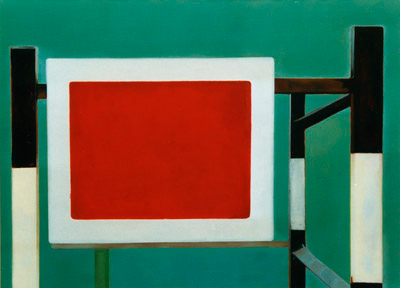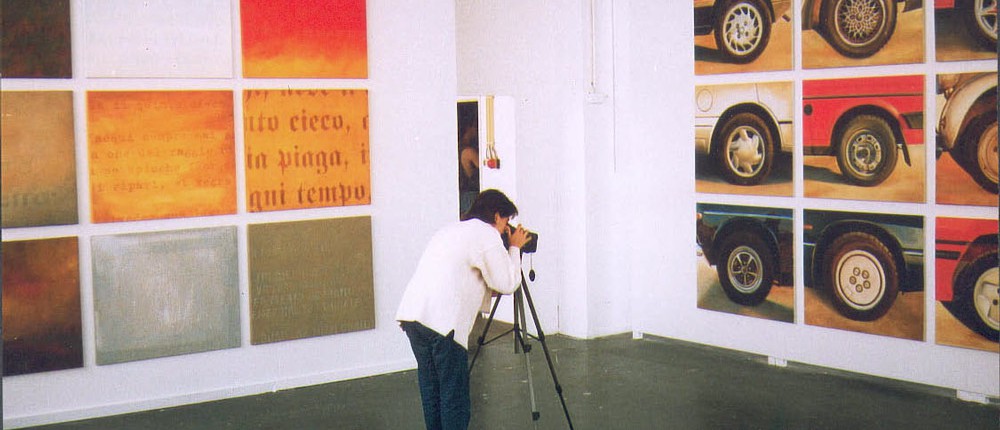MARÍA JOSÉ RAMÍREZ
Paintings – Art & the Theory I-II
Art and the Theory I (the nine blind men)
(1996). Oil on canvas, 9 canvases 80×95 cm. each
Art and the Theory I (the nine wheels)
(1995). Oil on canvas, 9 canvases 80×95 cm. each
From its inception, the origin and the title of this work, Art & the Theory, have constituted a union. An encounter with the book, Art in the Theory: An Anthology of Changing Ideas, proved of vital importance for its creation.
This book posited a synthesis of the diverse theories about art throughout history. After a general perusal of it and having read therein some particular ideas, I suddenly found myself before an impressive theoretical panorama.
Until then, I had only perceived minute views of this theoretical landscape through the confinement of “small windows”, like art journals, books or expositions. I knew the magnitude of this landscape, however I had not been able to experience it. In a fit, I envisioned the innumerable ideas and theories about art. That is, one’s constant preoccupation with defining art and the insatiable intent to institutionalize the different artistic currents, or drawing borders in an effort to define what art is or what art is not.
The reason for making the first nine canvases of this work corresponds to the aforementioned discussion and in particular the need to assure in certain artistic circles that art, above all, the art of painting, has somehow died.
The Nine Wheels
The images of the wheels function as a metaphor representative of the vital necessity and the impulse that any artist feels to create. They represent the movement, the desire to go somewhere simultaneously taking or transporting the spectator. The wheels represent an interrogation about the nature of art, the search for the progress or an evolution. Like the wheels of transport on Earth take us to different places, so too can the interrogation about the nature of art lead us to its different areas or diverse forms. New discoveries are constantly being made and although new currents have emerged, they nonetheless concurrently revert to the past. The original shape of the wheel-roundness- has not changed in form since its invention. However, over time, the materials employed for its fabrication have changed. Likewise, mediums utilized in creating art have also changed. But in my eyes, art’s original function, i.e. to communicate– has continued to date.
The wheel coverings depicted in these nine canvases represent the image destined for the retina in art. The surfaces, I mean what the expectator visualized, of the diverse currents which followed resulted in the visual aspect of art.
The conception of this work awoke in me a great curiosity for the bicycle wheel (ready made) of Marcel Duchamp. I believe my work has a certain affinity with the work of Duchamp, although not derived from his. In the words of author Octavio Paz, “Duchamp was a painter of ideas”. Duchamp utilized the object as a metaphor, or rather his reflection upon the object as a meditation of itself. Each of his works represents a diversity of significations or perspectives.
For the first nine canvases I have chosen wheel covers, which in my point of view could be associated with a predetermined artistic current. My intention has not been to simply make an enumeration of these diverse currents throughout the history of art. I wanted it also to be a painting. Thus, I decided not to use only the wheel covers and I have also limited this initial composition to nine canvases, arranged in one frame of three by three.
The following paragraph appeared in The Castle of Purity, a book that Octavio Paz wrote about Macel Duchamp’s “The Large Glass”. “The number nine has an immense prestige. Nine is three times three, and three is the number in which, according to Dumezil, the vision indo-europea of the world is concentrated. Nothing more original that Duchamp added one more bachelor to Ero’s Matrix, originally comprised of eight’.
The Nine Blind Men
In the process that emerges between the idea and the realization of the image a series of esoteric steps exist. Too, I desired to exhibit this aspect of my work. I searched for texts of artists representative of the different artistic currents with the idea of forming an image that could relieve it. Once again as if in a cyclical/circular movement I came head to head with Marcel Duchamp. I moved passed the writings of the book El Signo y el Garabato, which would influence the formal aspect of the second tier of canvases, to The Castle of Purity. In the latter book, Paz, detected a correlation between the book of the humanist Giordano Bruno, Eroici Furori (1585) and “The Large Glass”.
” The hero, the furious lover is multiplicated into nine blindmen. Each one recites a poem that defines the type of the blindness affliction. The nine blindmen represent nine of the physical and psychological limitations of the lover….we see more with our eyes closed than with them opened.”
Actually, these were the nine texts that I had sought. My doubts subsided when I read the following paragraph in Ann van Sevenant’s Het Verhaal van de Filosofie/The Story of Philosophy.”The influence of the humanist movement in the development of the spiritual liberty of artists should not be thwarted. The humanists of the renaissance: Petrarca, Boccacio, Giordano Bruno…in conjunction with the artists of the Renaissance….. of the birth of the principal of unity in art such as it is known today. The culmination of the arts in its plural form to the art in the singular orm dates from this epoch”.
With this text in hand, the circle closed itself.
The texts that I utilized in the canvases that form the second frame pertain to the poems of the nine blindmen by Bruno. Each text corresponds to one of the nine wheelcovers in the first frame. One could say that half of the totality of this work is the reflection of the other half.
Again, with respect to the formal aspect of the second part of this work, Octavio Paz’ El Signo y el Garabato, has been of crucial importance for the fruition of the formal aspect of this work. I intuitively chose a particular typography for each of the nine canvases depicting Bruno’s poems of the blind. These typographies, in their formal aspects, have a direct association with the distinctive artistic currents throughout history. As I painted these canvases, I wanted, among other ideas, to revive the visual with the written, independent of their contents.
The trajectory that I have followed up until I found the definitive form of Art & the Theory can be described as cyclical/circular. My intention in having made a distribution of the images in a number of canvases has been to create an open painting, one which could be assembled or disassembled- a type of mobile work. With the opening of this work to the interested spectator I have wanted to initiate a dialogue or give way to a discussion with the aim of attempting to find responses to yet unformulated interrogations.
María José Ramírez Ramírez, Amsterdam, May 1996

